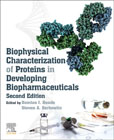
Biophysical Characterization of Proteins in Developing Biopharmaceuticals
Houde, Damian J.
Berkowitz, Steven A.
Biophysical Characterization of Proteins in Developing Biopharmaceuticals, second edition is concerned with the analysis and characterization of the higher-order structure (HOS) or conformation of protein based drugs. Starting from the very basics of protein structure this book takes the reader on a journey on how to best achieve this goal using the key relevant and practical methods commonly employed in the biopharmaceutical industry today as well as up and coming promising methods that are now gaining increasing attention. As a general resource guide this book has been written with the intent to help today's industrial scientists working in the biopharmaceutical industry or the scientists of tomorrow who are planning a career in this industry on how to successfully implement these biophysical methodologies. In so doing a keen focus is placed on understanding the capability of these methodologies in terms of what information they can deliver. Aspects of how to best acquire this biophysical information on these very complex drug molecules, while avoiding potential pitfalls, in order to make concise, well informed productive decisions about their development are key points that are also covered. This second edition has been fully revised and updated, and includes new chapters on the use of chromatography & electrophoresis; biophysical characterization of very large biopharmaceuticals; rigor, significance, and best practices of applying statistical analysis to biophysical characterization data; practical issues and best practices associated with the concept of a biopharmaceutical's developability; and technical decision-making processes when dealing with biophysical characterization data. Presents basic protein characterization methods and tools applicable to (bio)pharmaceutical research and developmentHighlights the capabilities and limitations of each techniqueDiscusses the underlining science of each toolEmpowers industrial biophysical chemists by providing a road map for applying biophysical toolsOutlines the needs for new characterization and analytical tools in the biopharmaceutical industry INDICE: I: Proteins and Biophysical Characterization in the Biopharmaceutical Industry 1. The Complexity of Protein Structure and the Challenges it Poses in Developing Biopharmaceuticals 2. Biophysical Characterization and Its Role in the Biopharmaceutical Industry 3. Biopharmaceutical Industry's Biophysical Toolbox II: The Selected Biophysical Tools in the Biopharmaceutical Industry 4. An Introduction and Hierarchical Organization of the Biophysical Tool 5. The Value of UV, Fluorescence, and FTIR Spectroscopy in Biopharmaceutical Development 6. Circular Dichroism Spectroscopy for Protein Characterization: Biopharmaceutical Applications 7. Size-Exclusion Chromatograph (SEC) in Biopharmaceutical Process Development 8. Scattering Techniques for the Characterization of Biopharmaceuticals 9. Characterizing Biopharmaceuticals using Analytical Ultracentrifugation 10. Sub-visible and Visible Particle Analysis in Biopharmaceutical Research and Development 11. Differential Scanning Calorimetry in the Biopharmaceutical Sciences 12. Biophysical Mass Spectrometry for Biopharmaceutical Process Development: Focus on Hydrogen/Deuterium Exchange 13. One- and Two-Dimensional NMR Techniques for Biopharmaceuticals 14. Use of Chromatography and Electrophoresis for indirectly assessing Biophysical Characterization III: Concluding Remarks on the Biophysical Characterization of Biopharmaceuticals 15. Biophysically Characterization of very large Biopharmaceuticals 16. Statistical Analysis of Biophysical Characterization Data 17. Biopharmaceutical Developability 18. Technical Decision-making dealing with Biophysical Characterization Data 19. Biophysical Characterization: An Integral Part of the Totality of the Evidence Concept
- ISBN: 978-0-444-64173-1
- Editorial: Elsevier
- Encuadernacion: Rústica
- Páginas: 512
- Fecha Publicación: 01/09/2019
- Nº Volúmenes: 1
- Idioma: Inglés
